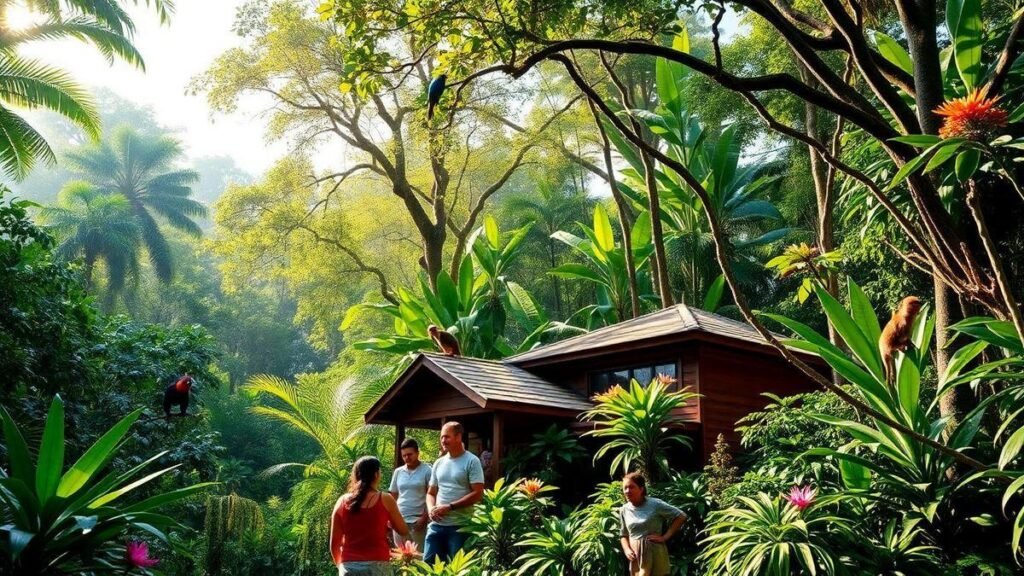Sustainable tourism practices for preserving biodiversity in tropical rainforests are essential for protecting our precious ecosystems. In this article, you’ll discover how
eco-friendly travel not only helps save
wildlife but also supports local communities. From understanding the impact of tourism to learning about community-based initiatives, you’ll see how we can all make a
positive change. So, let’s dive into the world of sustainable tourism and explore how we can enjoy nature while keeping it safe!
Important Points to Remember
- You can help protect rainforests by choosing eco-friendly tours.
- Support local communities by buying their crafts and food.
- Always follow the rules in protected areas to keep wildlife safe.
- Reduce waste by bringing reusable items like water bottles.
- Share what you learn about rainforests to inspire others.
The Importance of Sustainable Tourism for Biodiversity Conservation
How Sustainable Tourism Practices Protect Rainforest Ecosystems
When you think about visiting a rainforest, it’s easy to get lost in the beauty of towering trees and vibrant wildlife. But did you know that
sustainable tourism practices play a crucial role in protecting these ecosystems? By choosing eco-friendly options, you help preserve the delicate balance of life in these areas.For example, many tour companies now focus on
responsible travel. They limit the number of visitors in sensitive areas, ensuring that wildlife isn’t disturbed. This means you can enjoy the sights and sounds of the rainforest while knowing you’re making a positive impact.Here are some ways sustainable tourism practices help:
- Minimizing Waste: Tour operators often promote recycling and waste reduction.
- Supporting Local Communities: Your travel dollars can help local people thrive, promoting conservation.
- Educating Travelers: Many tours include information on the importance of biodiversity.
The Role of Eco-Friendly Travel in Wildlife Protection
Eco-friendly travel is more than just a trend; it’s a way to protect wildlife. By choosing eco-conscious accommodations and activities, you contribute to the
conservation of habitats.Consider this: when you stay at a lodge that uses solar energy or practices water conservation, you’re reducing your carbon footprint. This not only helps the environment but also supports local wildlife.Here’s how you can make a difference:
| Eco-Friendly Actions | Impact on Wildlife |
|---|
| Choosing eco-lodges | Reduces habitat destruction |
| Participating in guided tours | Supports conservation efforts |
| Engaging in wildlife monitoring | Helps track animal populations |
Understanding the Impact of Tourism on Rainforest Biodiversity
Tourism can have both positive and negative effects on rainforest biodiversity. On one hand, it brings awareness and funding for conservation. On the other hand, if not managed well, it can harm delicate ecosystems.For instance, when too many visitors trample trails, it can lead to soil erosion and damage to plant life. This is why
sustainable tourism practices for preserving biodiversity in tropical rainforests are vital.To truly understand this impact, think about the following:
- Visitor Education: Learning about the ecosystem can help you appreciate its value.
- Regulated Access: Limiting the number of visitors helps protect sensitive areas.
- Conservation Funding: Many tourism fees go directly to conservation projects.
Community-Based Tourism and Its Benefits for Tropical Rainforest Preservation
Engaging Local Communities in Sustainable Tourism Practices
When you think about
sustainable tourism, consider how important it is to involve
local communities. They are the heartbeat of the tropical rainforest. By engaging them, you help preserve their culture and environment. Imagine staying in a cozy lodge run by local families. You get to learn about their traditions, while they benefit from your visit. This connection helps the community thrive and keeps the rainforest safe.
Community-based tourism is a fantastic way to support
biodiversity conservation. When locals are involved, they take pride in protecting their land. They know it better than anyone else! For instance, local guides can show you the diverse wildlife and plants that call the rainforest home. They share their knowledge, and you get a deeper understanding of the ecosystem. This relationship creates a win-win situation for both you and the environment.
| Benefit | Description |
|---|
| Local Knowledge | Locals provide insights about wildlife and plants. |
| Cultural Exchange | You learn about their traditions and way of life. |
| Economic Support | Your visit helps create jobs and supports local businesses. |
| Conservation Awareness | Locals become more aware of the importance of protecting their environment. |
The Positive Effects of Responsible Tourism on Local Economies
When you practice
responsible tourism, you directly impact local economies. Your spending helps create jobs and sustain local businesses. Think about it: every meal you enjoy, every souvenir you buy, and every tour you take contributes to the community’s well-being.
- Job Creation: More tourists mean more jobs for locals.
- Support for Local Businesses: Your dollars support shops, restaurants, and markets.
- Community Projects: Some of your money goes into projects that help the environment and community.
In the end, your choice to engage in
sustainable tourism practices for preserving biodiversity in tropical rainforests can make a real difference.
Environmental Education and Its Role in Sustainable Travel Initiatives
Raising Awareness About Rainforest Ecosystems Through Tourism
When you travel, you have the chance to
learn about the
amazing rainforest ecosystems. These forests are home to countless plants and animals. By visiting these areas, you can see how
important they are for our planet.Tour companies often offer guided tours that focus on the
biodiversity of rainforests. They teach you about different species, their roles, and how they all connect. This education helps you appreciate the beauty around you and understand the need to protect it.
The Benefits of Educating Travelers on Biodiversity Preservation
Educating travelers about biodiversity has many
benefits. Here are a few:
- Increased Awareness: You become more aware of the issues facing rainforests.
- Support for Local Communities: When you learn about the importance of these ecosystems, you’re more likely to support local conservation efforts.
- Personal Responsibility: Education helps you feel responsible for the environment. You may choose to make eco-friendly choices in your daily life.
Here’s a quick look at how education impacts your travel experience:
| Impact | Description |
|---|
| Awareness | You learn about the importance of rainforests. |
| Support | You may choose to support local conservation. |
| Choices | You make eco-friendly choices in your travels. |
Creating Lasting Change Through Sustainable Tourism Education
When you engage in
sustainable tourism education, you can create lasting change. By sharing what you learn, you inspire others to care about the environment. This ripple effect can lead to more people joining the cause to protect our rainforests.Consider this: every time you tell a friend about the wonders of a rainforest, you’re spreading knowledge. This knowledge can lead to
action. People may choose to travel responsibly, support conservation projects, or even advocate for policies that protect these vital ecosystems.
Frequently Asked Questions
What are some sustainable tourism practices for preserving biodiversity in tropical rainforests?
You can support local communities, choose eco-friendly tours, and stay at green hotels. These practices help protect wildlife and plant life.
How does sustainable tourism benefit the local communities?
When you choose sustainable tourism, the money you spend helps local people. It creates jobs and encourages them to protect their environment.
Can I see wildlife while supporting sustainable tourism?
Absolutely! Many eco-tours let you see animals in their natural habitats without hurting them. This is a key part of
sustainable tourism practices for preserving biodiversity in tropical rainforests.
Why is it important to preserve biodiversity in tropical rainforests?
Biodiversity keeps the rainforest healthy. It supports ecosystems, helps fight climate change, and provides resources for future generations.
What can I do as a tourist to help sustain the rainforest?
You can reduce waste, respect wildlife, and learn about the local culture. Small actions can significantly impact the preservation of biodiversity.

